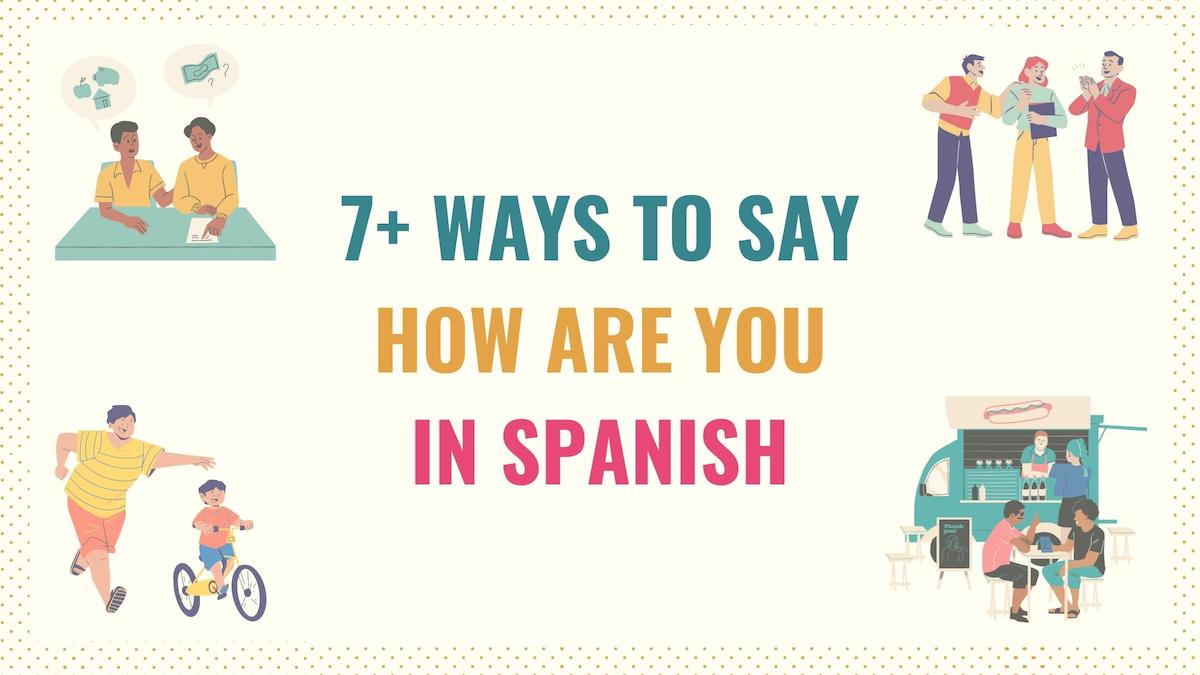I know, I know. ‘¿Cómo estás?’ is one of the first phrases you learned. But what if I told you that we actually have other common ways to say how are you in Spanish? And why wouldn’t you want to learn them? Because they will make you sound less repetitive and more natural!
So, if you’re wondering how do you say how are you in Spanish, in this guide, I’ll show you 8 expressions (and their variations) that you can use to say ‘how are you’ like a native Spanish speaker!
Just a heads-up! Not all of these phrases will be suitable for all situations. So, make sure you check the examples and descriptions. I’m also going to include examples for asking someone how other people are as well, so you can make the most of the different ways to ask how someone is in Spanish.
1. ¿Cómo estás? – How are you?

¿Cómo estás? is the most standard expression you can use in this context. As a result, you can use this question in both formal and informal Spanish. Since ‘¿cómo estás?’ is meant to address a person (tú), you will need to conjugate the verb ‘estar’ to address different people:
¡Hola! ¿Cómo estás?
Hey, how are you?
Oye, Paulina, ¿cómo está Celia?
Hey, Paulina, how is Celia?
¡Qué gusto verte! ¿Cómo están tus papás?
It’s so nice to see you! How are your parents?
Buenos días, ¿cómo está, señor López?
Good morning, how are you, Mr. López?
To make this expression more formal, you need to conjugate ‘estar’ to the third person singular (‘usted’). Also, you can conjugate this expression to the preterite tense to ask how something or someone was.
2. ¿Cómo andas? – How is it going?

If you’re looking for an informal expression, ‘¿cómo andas?’ is a good option to use with your friends and family. This Spanish phrase means ‘how is it going?’ or ‘how are you doing?’.
¡Qué onda, amiga! ¿Cómo andas?
What’s up, pal? How is it going?
Y, ¿cómo anda tu hermano?
How is your brother doing?
¿Cómo andan, chicos? ¿Todo bien?
How are you, boys? Everything okay?
With this meaning, andar is always conjugated in the present tense.
Take Note: The Spanish verb andar is an informal synonym of the ‘estar’. However, the only application where you cannot interchange these verbs is when talking about location.
3. ¿Cómo te va? – How are you doing?

¿Cómo te va? is another informal way to ask someone how things are going. We typically use this expression when we’ve heard about the other person for a while. In other words, this is not a phrase you’d use as a daily greeting.

‘¿Cómo te va?’ is close in meaning to ‘how are you doing?’, ‘how is it going?’ or ‘how are you?’. Although it doesn’t sound as cool as Joey’s (from Friends) “how are you doing?”, you can use ¿cómo te va? when talking to a boy or girl.
¿Cómo + [indirect object pronoun] + va + a + (person)?
¿Cómo te va, bonita?
How are you doing, beautiful?
¿Cómo me va? Bien, no me puedo quejar.
How am I? Good, I can’t complain.
¿Sabes algo de Andrew? ¿Cómo le va?
Have you heard from Andre? How is he?
Take Note: You can also use the variations ‘¿cómo te ha ido?’ and ‘¿cómo va todo?’ with the same meaning. As a conversation tip, the present progressive form ‘¿cómo te está yendo?’ is used to ask people how they’re doing with an activity.
4. ¿Qué tal? – How is it going? / How are you?

In Castilian Spanish, ¿qué tal? is a casual synonym of ‘¿cómo estás?’. Pay attention to the context because this expression is used as a greeting in other Spanish-speaking countries.
Hola, guapa, ¿qué tal?
Hi, beautiful, how are you?
¡Adam! ¿Qué tal? ¿Cómo estuvo tu viaje?
Adam! How is it going? How was your trip?
In Latin American Spanish-speaking countries, we use the full version ¿qué tal estás?. This expression is not only a more formal way to say ‘how are you’ in Spanish, but it also allows you to ask about other people.
Buenos días, ¿qué tal está?
Good morning, how are you?
¡Cuánto tiempo sin verte! ¿Qué tal estás?
Long-time, no see! How is it going?
Take Note: In Latin America, ‘¿qué tal?’ can also work as a greeting. Additionally, you can also use it to respond to the question ¿cómo estás?
Yo bien y tú, ¿qué tal?
I’m fine, how about you?
5. ¿Cómo te encuentras? – How are you?

‘¿Cómo te encuentras?’ is a helpful expression to say ‘how are you?’ more formally. Usually, we ask this question to a person who has been sick or has gone through a rough patch. Depending on the context, it could also be translated as ‘how are you feeling?’ or ‘how are you doing?’.
‘¿Cómo sigues?’ is a more casual way to pose the same question.
¿Cómo + [reflexive pronoun] + [‘encontrar’/ ‘seguir’ present tense]?
¿Cómo se encuentra, señora Alicia?
How are you, Mrs. Alicia?
¿Cómo te encuentras, mamá?
How are you, mom?
Amiga, ¿cómo siguen Ernesto y tú?
Amiga, how are you and Ernesto doing
6. ¿Cómo te trata la vida? – How are things going?

‘¿Cómo te trata la vida?’ is another informal question you can ask instead of ‘¿cómo estás?’. This expression is suitable for friends or family that we haven’t heard from in a long time. This question also conveys the idea that you want to catch up with that person.
It can be translated as ‘how are things going?’ and ‘how is life treating you?’.
¿Cómo + [direct object pronoun] + trata la vida?
¿Cómo las trata la vida, chicas?
How is life treating you, girls?
¡Qué onda, Rodrigo! ¿Cómo te trata la vida?
What’s up, Rodrigo! How is life treating you?
¡Qué bonita sorpresa! ¿Cómo te trata la vida?
What a nice surprise! How are things going?
Take Note: ‘¿Cómo te trata la vida?’ asks how things are going in this specific moment of life. You can use its variation ‘¿cómo te ha tratado la vida?’ if you want to enquire about both present and past points in life.
7. ¿Cómo has estado? – How have you been?

The Spanish question ‘¿cómo has estado?’ is a standard way to ask people how they have been. We use this phrase with people we haven’t seen or talked to in a while since it allows us to inquire about them up to this point in life.
Notice that you conjugate the verb ‘haber’ based on the person you want to address.
¿Alan? ¡Qué sorpresa! ¿Cómo has estado?
Alan? What a surprise! How have you been?
Hola, bonita, ¿cómo has estado?
Hi, gorgeous, how have you been?
Y, ¿cómo ha estado tu familia?
And how has your family been?
8. ¿Qué hay? – What’s up?

When it comes to informal Spanish, this is another phrase you can use in a casual situation. This expression means “what’s up” or “how is it going?”. Keep in mind that, in other contexts, this phrase can also be used as a Spanish greeting.
¡Qué hay! Mucho gusto.
What’s up! Nice to meet you!
Hola, ¿qué hay?
Hi, how is it going?
Spanish Responses to “How Are You”
Here are some common responses to cómo estás in Spanish:
- Muy bien: Very well
- Excelente: Great
- Más o menos: So, so
- A todo dar: Excellent
- Mal: Bad
In this guide, you can learn how to use these expressions as well as other ways to answer this question in Spanish.
How Are You in Spanish: Additional Resources
Now that you’ve learned different expressions you can use to ask how things are going. Here are some useful links that can help you improve your conversations. For example, learn some common expressions to say hi and goodbye in Spanish, so you can greet people more naturally.
Finally, learn to conjugate the verbs we just used in different tenses. That way, you’ll be able to apply these expressions in different situations. Here are some guides that you can start checking out:
Download PDF on Spanish Phrases to Ask How Are You
Feel free to download copy of the PDF with all ways to say how are you in Spanish so you can incorporate into your vocabulary over time! It contains all Spanish phrases from this article as well as English and Spanish examples and tips on using them.



